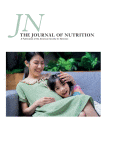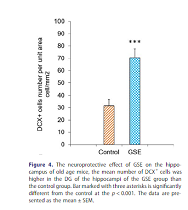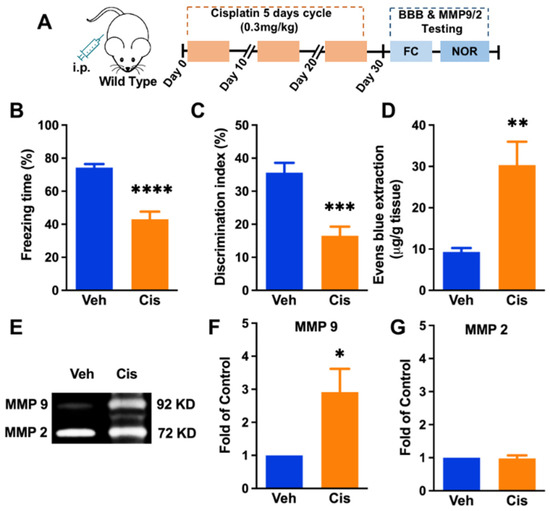The smaller nanoparticles specifically are dangerous. and no way of telling what you're getting with the silicon dioxide often found in supplements
Maternal exposure to silicon dioxide nanoparticles reduces hippocampal neurogenesis and synaptogenesis and induces neurodegeneration in rat offspring hippocampus
wasnt a crazy dose either. 250mg - 300mg human equivalent , orally
(silicon dioxide is found in a lot of them), and especially if they don't have sufficient oxidative stress protection
DCX+ neuronal precursor cells are like stem cells for the brain.
increased expression means they are actively replicating and maturing into more neurons (more neurogenesis is happening)
Modulatory effect of coffee fruit extract on plasma levels of brain-derived neurotrophic factor in healthy subjects
^ in humans they used silica dioxide as a "placebo", which reduced blood BDNF by 34%
Low neurogenesis in the hippocampus is linked to depression & poor cognition
----
For restoring hippocampus neurogenesis i like grape seed proanthocyanidin extract, shown to have a profound effect on cognition in aged mice and >2x increase in hippocampal DCX+ cells.
In the study above they used 100mg of GSE which improved blood BDNF levels in humans. not as much as coffeeberry , because of the extract type. They used GSE high in polyphenols but not standardized to high as **** proanthocyanidins
There's a big difference between GSE and GSPE (grape seed proanthocyanidin extract). GSPE is almost all procyanidins. so with GSE you'd need a much higher dose, and get other stuff you might not want idk
procyanidins are one of the most potent compounds for increasing BDNF / neurogenesis

It has a big impact on increasing exercise time to exhaustion - ~250mg-300mg human dose extended from 8.6 minutes to 13 minutes (+50% improvement). 500mg increased to 16.63 minutes
.lowered lactic acid 12.44 -> 9.51
.raised oxidative stress protection enzymes, lowered MDA (250mg is close to 500mg dose effects)
.slight anti-inflammatory effect (mild not major, but should also benefit immunity so its a bonus)
. improved 2 mitochondria function markers in muscle +20% (ATPase and Succinate DH SDH)
even small doses have some effect
Grape seed proanthocyanidin extract protects lymphocytes against histone-induced apoptosis protects lymphocytes (& mitochondria)
and actually induced TH1 Grape Seed Extract Activates Th1 Cells In Vitro so should boost immunity [this is the procyanodins rich extract]
The reason why red wine has some benefits associated vs other alcohols is because it has these procyanidins. usually alcohol damages immunity. but red wine in reasonable amounts (360ml) protects against the immune damaging effects , and increases NK cell ratio.
small study size but should be legit

 www.sciencedirect.com
www.sciencedirect.com
GSPE also helps mitochondria function (if timed right) which is the basis for cellular energy
better mitochonrial effect administered in night time in rats (so day time for humans? when more metabolically active). . Time-of-Day Circadian Modulation of Grape-Seed Procyanidin Extract (GSPE) in Hepatic Mitochondrial Dynamics in Cafeteria-Diet-Induced Obese Rats probs will go with <12pm. Rats are nocturnal , so during their wake phase (night time) mitochondrial fusion genes go to 1.5x to 2x expression with GSPE instead of when taken during their sleep phase (day time). https://www.mdpi.com/nutrients/nutr...eploy/html/images/nutrients-14-00774-g004.png
*250mg - 500mg is a good dose.
GSPE induces cell death in leukemia cells without harming normal cells
Protects against oxidative stress with multiple x more potency than Vit C or Vit E. shown protective against toxic metals with cadmium study. The protective effect of grape seed procyanidin extract against cadmium-induced renal oxidative damage in mice - PubMed
restorative in diabetes https://www.researchgate.net/public...turbances_of_Red_Blood_Cells_in_Diabetic_Rats
------ possible downsides ------
.Some concerns is potential to inhibit cholesterol synthesis , and fat digestion by inhibiting fat digesting enzymes and binding in intestine Inhibitory effects of grape seed extract on lipases . havent looked into doses in vivo for this yet.
.i would take it away from iron foods unless trying to decrease iron, due to the binding & less absorption
.Inhibiting MAO-A too much = skew towards much higher serotonin. in rats this leads to a more fearful character with increased aggressiveness. some toxic things like cadmium causes MAO-A inhibition. & the spice pepper etc
Aggressive Behavior and Altered Amounts of Brain Serotonin and Norepinephrine in Mice Lacking MAOA MAO-A lowering from normal lvls -> more fearful & more aggressive. 9x more serotonin and 2x more norepinephrine (mao-a inhibition is way more serotonergic)
GSPE (procyanidins) inhibits MAO-A in the brain BUT also MAO-B with similar potency, and the effect is mild ~15% at a 250mg-300mg dose
nice study on neurotransmitter effects of GSPE (just the procyanidins) in different brain regions https://kd.nsfc.gov.cn/paperDownload/1000001091895.pdf
there's a dose dependent effect on raising brain serotonin, norepinephrine and dopamine. may be best to stick to 250mg human dose . i saw another less detailed study where 2gram amounts raised whole brain serotonin more than dopamine, slightly higher than baseline, and tanked noradrenaline (did not inhibit acetylcholinesterase which is a positive for many tho).
so no need for gram amounts. in lower active doses dopamine is raised more. by 7 days
frontal cortex: serotonin 515 -> 628 [+20%]
dopamine 17.4 -> 29.3 [+70%]
both metabolites lower
hippocampus: serotonin 615 -> 708 [+15%]
dopamine: 23.6 -> 36.1 [+50%]
hypothalamus: serotonin 424 -> 549 [+30%]
dopamine 16.1 -> 20.9 [+30%}
So while it does raise serotonin, it raises dopamine more. and noradrenaline also rises.

green coffee extract doesnt have procyandins or enough of them. coffeeberry / fruit does with the right extract (not the caffeine one it should be like 1% caffeine). but GSPE is 95% procyanidins.
BDNF brain cell generation benefits should hit in low doses. the ~30% blood BDNF increase in humans was from 100mg of GSE (low in procyanidins) ~150mg also worked here Grape seed extract enhances neurogenesis in the hippocampal dentate gyrus in C57BL/6 mice - PubMed but not sure on the extent. so even lower doses of GSPE should have effect,
Vitamin D also increases neurogenesis in hippocampus Anti-apoptotic and neurogenic properties in the hippocampus as possible mechanisms for learning and memory improving impacts of vitamin D in hypothyroid rats during the growth period - PubMed
GSE increases intracellular ATP production Grape skin extract modulates neuronal stem cell proliferation and improves spatial learning in senescence-accelerated prone 8 mice
-
want to find out how significant the cholesterol esterase inhibition & bile acid binding is at what doses (cholesterol is protective & needed)
can we assume GSPE dose is 5x equivalent of GSE?
https://www.researchgate.net/public..._vinifera_L_and_its_antihyperlidemic_activity
^ 1g human dose equivalent of GSE (not GSPE) inhibited cholesterol acutely ~5% in rats fed high fat diet. <_250mg GSPE may be insignificant?
Maternal exposure to silicon dioxide nanoparticles reduces hippocampal neurogenesis and synaptogenesis and induces neurodegeneration in rat offspring hippocampus
wasnt a crazy dose either. 250mg - 300mg human equivalent , orally
This is likely 1 reason why some people feel worse on a bunch of supplements that are supposed to be having benefitsSilicon dioxide nanoparticles (SiO2-NPs) are among the most widely used nanoparticles because of their chemical-physical properties. Since most brain maturation occurs in the neonatal period in humans and many mammals, it is important to understand how NPs may affect this process. This study tested the hypothesis that SiO2-NPs from treated dams could affect the hippocampus of neonatal rats during lactation.
Twenty-four pregnant rats, after delivery, were divided into three groups of control, SiO2-NPs (25 mg/kg) and SiO2-NPs (100 mg/kg). The rats were treated from 2nd to 21st days post-delivery by gavage and the effects of these NPs were evaluated in the offspring’s hippocampi to reveal the effects of maternal exposure to SiO2-NPs during lactation on the offspring’s hippocampi.
The offspring in the SiO2-NPs groups had higher malondialdehyde concentration and lower antioxidant activity in the hippocampi than the non-treated control group. The mean number of doublecortin positive (DCX+) cells and synaptophysin expression in the hippocampi of the SiO2-NPs groups were significantly lower than the control group, whereas the mean number of dark neurons was significantly higher. Also, animals in the SiO2-NPs groups had a weak cognitive performance in adulthood. In conclusion, maternal exposure to SiO2-NPs via breastfeeding could affect offspring’s hippocampal neurogenesis and synaptogenesis, leading to impaired cognitive performance.
(silicon dioxide is found in a lot of them), and especially if they don't have sufficient oxidative stress protection
DCX+ neuronal precursor cells are like stem cells for the brain.
increased expression means they are actively replicating and maturing into more neurons (more neurogenesis is happening)
Modulatory effect of coffee fruit extract on plasma levels of brain-derived neurotrophic factor in healthy subjects
^ in humans they used silica dioxide as a "placebo", which reduced blood BDNF by 34%
Quite unexpectedly, treatment with placebo (silica dioxide) resulted in a 34 % reduction in BDNF blood levels (P¼0·09
Low neurogenesis in the hippocampus is linked to depression & poor cognition
----
For restoring hippocampus neurogenesis i like grape seed proanthocyanidin extract, shown to have a profound effect on cognition in aged mice and >2x increase in hippocampal DCX+ cells.
In the study above they used 100mg of GSE which improved blood BDNF levels in humans. not as much as coffeeberry , because of the extract type. They used GSE high in polyphenols but not standardized to high as **** proanthocyanidins
There's a big difference between GSE and GSPE (grape seed proanthocyanidin extract). GSPE is almost all procyanidins. so with GSE you'd need a much higher dose, and get other stuff you might not want idk
procyanidins are one of the most potent compounds for increasing BDNF / neurogenesis
It has a big impact on increasing exercise time to exhaustion - ~250mg-300mg human dose extended from 8.6 minutes to 13 minutes (+50% improvement). 500mg increased to 16.63 minutes
.lowered lactic acid 12.44 -> 9.51
.raised oxidative stress protection enzymes, lowered MDA (250mg is close to 500mg dose effects)
.slight anti-inflammatory effect (mild not major, but should also benefit immunity so its a bonus)
. improved 2 mitochondria function markers in muscle +20% (ATPase and Succinate DH SDH)
even small doses have some effect
Grape seed proanthocyanidin extract protects lymphocytes against histone-induced apoptosis protects lymphocytes (& mitochondria)
and actually induced TH1 Grape Seed Extract Activates Th1 Cells In Vitro so should boost immunity [this is the procyanodins rich extract]
The reason why red wine has some benefits associated vs other alcohols is because it has these procyanidins. usually alcohol damages immunity. but red wine in reasonable amounts (360ml) protects against the immune damaging effects , and increases NK cell ratio.
small study size but should be legit

Wine Modifies the Effects of Alcohol on Immune Cells of Mice
Ethanol may be detrimental to immune cells due to the generation of free radicals during detoxification. If this is true, then alcoholic beverages tha…
GSPE also helps mitochondria function (if timed right) which is the basis for cellular energy
better mitochonrial effect administered in night time in rats (so day time for humans? when more metabolically active). . Time-of-Day Circadian Modulation of Grape-Seed Procyanidin Extract (GSPE) in Hepatic Mitochondrial Dynamics in Cafeteria-Diet-Induced Obese Rats probs will go with <12pm. Rats are nocturnal , so during their wake phase (night time) mitochondrial fusion genes go to 1.5x to 2x expression with GSPE instead of when taken during their sleep phase (day time). https://www.mdpi.com/nutrients/nutr...eploy/html/images/nutrients-14-00774-g004.png
*250mg - 500mg is a good dose.
helps restore complex i and ii activity a little, by 7 hrs after takingThe most remarkable result is that there is a clear overexpression in both Mnf1 and Mfn2, a 27 and 65% increment, respectively, in the GSPE group in the night treatment (ZT12) compared with the CAF-VH group. Altogether, these results could suggest that the effect of GSPE inducing the fusion of mitochondria seems to be more relevant with night treatment and shortly after GSPE ingestion (ZT1) in cafeteria-fed animals Altogether, these results could suggest that the effect of GSPE inducing the fusion of mitochondria seems to be more relevant with night treatment and shortly after GSPE ingestion (ZT1) in cafeteria-fed animals
Regarding the GSPE effect, a decrease of almost 30 percent in Fis1 gene expression is observed in the ZT13 condition. As some of these effects were also observed for the fusion genes, it seems that morning GSPE treatment promotes a relatively mild effect and prompts an equilibrium between the fusion and fission events, suggesting that there could be a balance in the morphology of the mitochondrial population.
In consequence, it seems that in the night treatment, mitochondria could be more present in an elongated/fussed form due to both the induction of fusion genes and the inhibition of fission genes induced by GSPE.
Interestingly, we observed that as expression of Fis1 and/or Drp1 in CAF-VH group decreases, concentrations of TCA metabolites increase at the same time of death.<-- but they noticed increase in TCA cycle metabolites during AM administration of GSPE , why if this was creating more fission?
In this sense, our results show that circadian oscillations of Rorα and Bmal1 were disrupted in the CAF-diet group and that GSPE was able to restore this disruption of both clock genes when treated at night restores circadian rhythm?
increase in the expression of mitochondrial fission genes, can result in fragmented mitochondria that are susceptible to apoptosis
Notably, the major improvements in GSPE supplementations were seen at the ZT12 dosage (12 hours after dosing). This may be partially explained by the fact that GSPE enhances the energy profile of rats and improves mitochondrial function and oxidation in the liver at night, during the active phase when rats are metabolically more active, as rats are nocturnal animals
GSPE induces cell death in leukemia cells without harming normal cells
Protects against oxidative stress with multiple x more potency than Vit C or Vit E. shown protective against toxic metals with cadmium study. The protective effect of grape seed procyanidin extract against cadmium-induced renal oxidative damage in mice - PubMed
restorative in diabetes https://www.researchgate.net/public...turbances_of_Red_Blood_Cells_in_Diabetic_Rats
------ possible downsides ------
.Some concerns is potential to inhibit cholesterol synthesis , and fat digestion by inhibiting fat digesting enzymes and binding in intestine Inhibitory effects of grape seed extract on lipases . havent looked into doses in vivo for this yet.
.i would take it away from iron foods unless trying to decrease iron, due to the binding & less absorption
.Inhibiting MAO-A too much = skew towards much higher serotonin. in rats this leads to a more fearful character with increased aggressiveness. some toxic things like cadmium causes MAO-A inhibition. & the spice pepper etc
Aggressive Behavior and Altered Amounts of Brain Serotonin and Norepinephrine in Mice Lacking MAOA MAO-A lowering from normal lvls -> more fearful & more aggressive. 9x more serotonin and 2x more norepinephrine (mao-a inhibition is way more serotonergic)
A line of transgenic mice was isolated in which transgene integration caused a deletion in the gene encoding MAOA, providing an animal model of MAOA deficiency. In pup brains, serotonin concentrations were increased up to ninefold, and serotonin-like immunoreactivity was present in catecholaminergic neurons. In pup and adult brains, norepinephrine concentrations were increased up to twofold, and cytoarchitectural changes were observed in the somatosensory cortex. Pup behavioral alterations, including trembling, difficulty in righting, and fearfulness were reversed by the serotonin synthesis inhibitor parachlorophenylalanine. Adults manifested a distinct behavioral syndrome, including enhanced aggression in males
GSPE (procyanidins) inhibits MAO-A in the brain BUT also MAO-B with similar potency, and the effect is mild ~15% at a 250mg-300mg dose
nice study on neurotransmitter effects of GSPE (just the procyanidins) in different brain regions https://kd.nsfc.gov.cn/paperDownload/1000001091895.pdf
there's a dose dependent effect on raising brain serotonin, norepinephrine and dopamine. may be best to stick to 250mg human dose . i saw another less detailed study where 2gram amounts raised whole brain serotonin more than dopamine, slightly higher than baseline, and tanked noradrenaline (did not inhibit acetylcholinesterase which is a positive for many tho).
so no need for gram amounts. in lower active doses dopamine is raised more. by 7 days
frontal cortex: serotonin 515 -> 628 [+20%]
dopamine 17.4 -> 29.3 [+70%]
both metabolites lower
hippocampus: serotonin 615 -> 708 [+15%]
dopamine: 23.6 -> 36.1 [+50%]
hypothalamus: serotonin 424 -> 549 [+30%]
dopamine 16.1 -> 20.9 [+30%}
So while it does raise serotonin, it raises dopamine more. and noradrenaline also rises.
green coffee extract doesnt have procyandins or enough of them. coffeeberry / fruit does with the right extract (not the caffeine one it should be like 1% caffeine). but GSPE is 95% procyanidins.
BDNF brain cell generation benefits should hit in low doses. the ~30% blood BDNF increase in humans was from 100mg of GSE (low in procyanidins) ~150mg also worked here Grape seed extract enhances neurogenesis in the hippocampal dentate gyrus in C57BL/6 mice - PubMed but not sure on the extent. so even lower doses of GSPE should have effect,
Vitamin D also increases neurogenesis in hippocampus Anti-apoptotic and neurogenic properties in the hippocampus as possible mechanisms for learning and memory improving impacts of vitamin D in hypothyroid rats during the growth period - PubMed
GSE increases intracellular ATP production Grape skin extract modulates neuronal stem cell proliferation and improves spatial learning in senescence-accelerated prone 8 mice
-
want to find out how significant the cholesterol esterase inhibition & bile acid binding is at what doses (cholesterol is protective & needed)
can we assume GSPE dose is 5x equivalent of GSE?
https://www.researchgate.net/public..._vinifera_L_and_its_antihyperlidemic_activity
^ 1g human dose equivalent of GSE (not GSPE) inhibited cholesterol acutely ~5% in rats fed high fat diet. <_250mg GSPE may be insignificant?
Attachments
Last edited:



